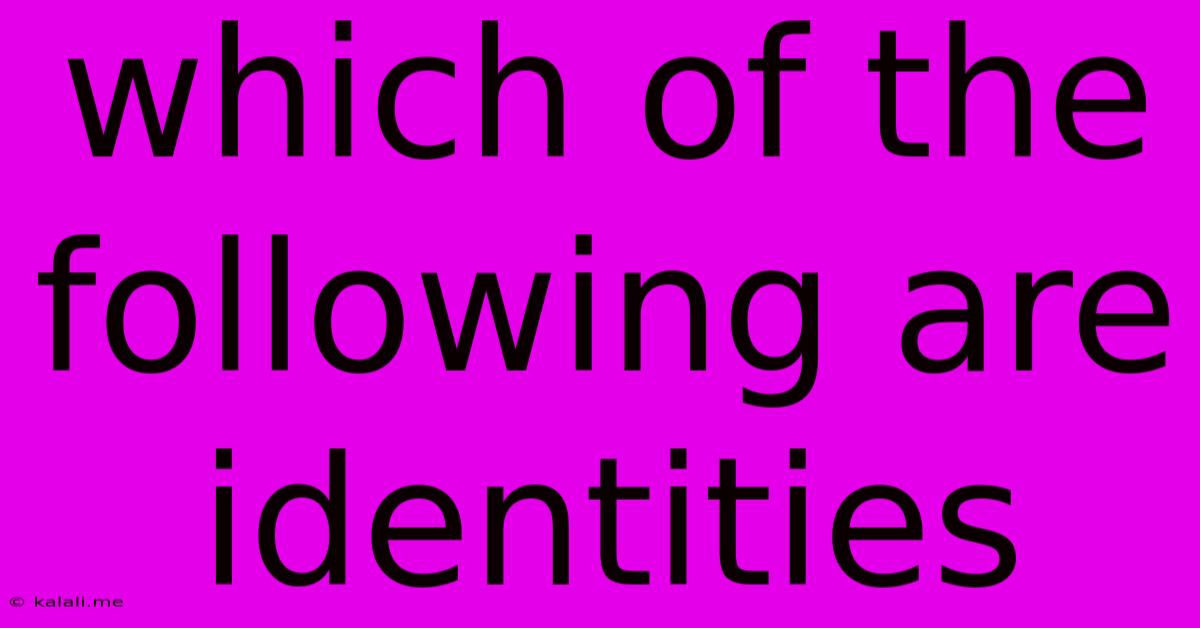Which Of The Following Are Identities
Kalali
Jun 14, 2025 · 3 min read

Table of Contents
Which of the Following Are Identities? A Deep Dive into Mathematical Truths
This article explores the concept of mathematical identities, clarifying what constitutes an identity and providing examples to solidify understanding. We'll delve into the differences between identities and equations, and offer strategies for identifying identities within a set of mathematical statements. Understanding identities is crucial for various mathematical disciplines, from algebra to calculus.
What is a Mathematical Identity?
A mathematical identity is an equation that is true for all values of its variables. Unlike equations that are only true for specific values, identities hold true universally. Think of them as fundamental truths within a mathematical system. For example, the equation x + x = 2x is an identity because it holds true regardless of the value of x.
Key Differences Between Identities and Equations:
- Identities: Always true, regardless of variable values. They represent fundamental relationships within a mathematical system.
- Equations: True only for specific values of the variables. Solving an equation involves finding these specific values.
How to Identify a Mathematical Identity:
Identifying an identity requires careful analysis. Here's a step-by-step approach:
-
Simplify: Simplify both sides of the equation as much as possible using algebraic manipulation (expanding brackets, combining like terms, etc.).
-
Check for Equivalence: After simplification, if both sides of the equation are identical, it's an identity. If they are different, it's an equation (or potentially a contradiction if no solutions exist).
-
Test with Values (Optional but Helpful): Substituting a few different values for the variables can help you quickly determine if an equation is likely an identity or not. However, this is not definitive proof; only complete algebraic simplification can confirm an identity.
Examples:
Let's analyze some examples to illustrate the concept:
Example 1: Is (x + 2)² = x² + 4x + 4 an identity?
- Simplification: Expanding the left side, we get x² + 4x + 4.
- Equivalence: Both sides are identical (x² + 4x + 4 = x² + 4x + 4).
- Conclusion: This is an identity.
Example 2: Is 2x + 5 = 11 an equation or an identity?
- Simplification: Subtracting 5 from both sides gives 2x = 6. Dividing by 2 gives x = 3.
- Equivalence: The simplified equation is only true when x = 3.
- Conclusion: This is an equation, not an identity.
Example 3: Is sin²(x) + cos²(x) = 1 an identity?
This is a fundamental trigonometric identity. It's true for all values of x (where x is an angle).
Example 4: Is x² - 4 = 0 an identity?
- Simplification: This simplifies to x² = 4, which gives x = ±2.
- Equivalence: This is only true for specific values of x.
- Conclusion: This is an equation, not an identity.
Conclusion:
Identifying mathematical identities requires a thorough understanding of algebraic manipulation and the ability to recognize fundamental mathematical relationships. By carefully simplifying and comparing both sides of an equation, we can confidently determine whether a given statement is an identity or simply an equation true for specific values. Mastering this skill is essential for success in various mathematical fields.
Latest Posts
Latest Posts
-
What Is The Factor Of 216
Jun 14, 2025
-
First Indian Gold Medal In Olympics
Jun 14, 2025
-
Which Of The Following Is A Measure Of Variability
Jun 14, 2025
-
The Distance From One Crest To The Next Is The
Jun 14, 2025
-
Which Of The Following Is Not An Essential Amino Acid
Jun 14, 2025
Related Post
Thank you for visiting our website which covers about Which Of The Following Are Identities . We hope the information provided has been useful to you. Feel free to contact us if you have any questions or need further assistance. See you next time and don't miss to bookmark.